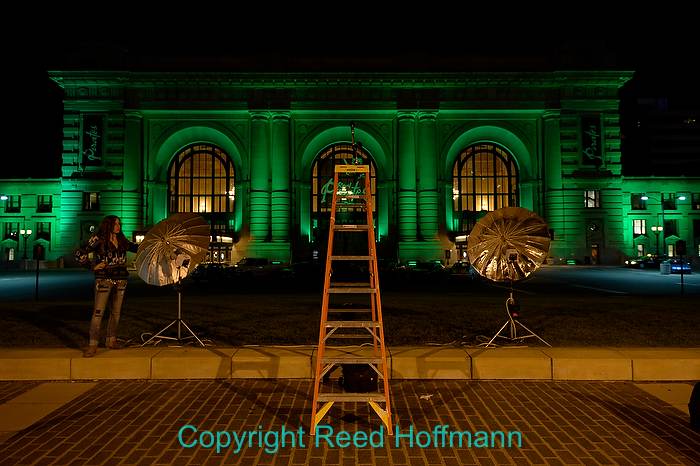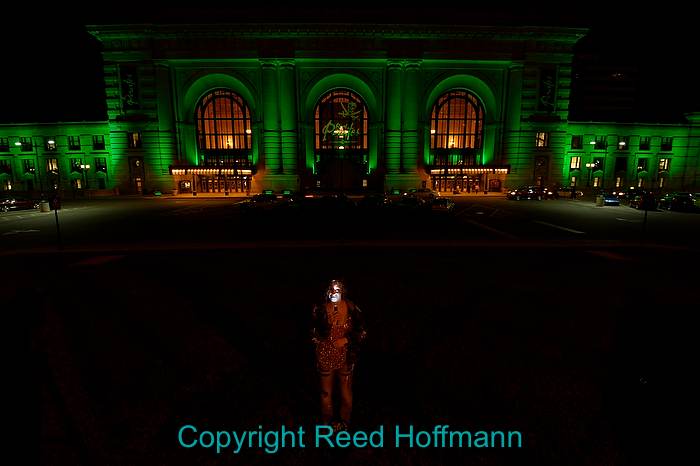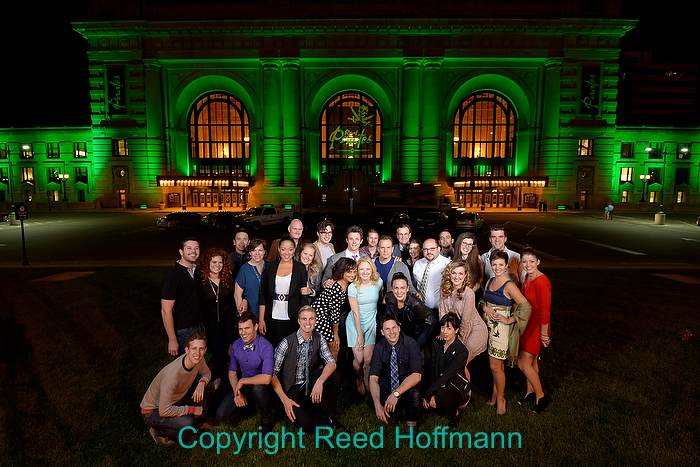This week the musical “Wicked,” started a three-week run in Kansas City. And that resulted in a phone call to me, and a late night photo shoot.
The call was from a PR person working with the production, and she wanted to know if I could help them make a special picture. Union Station in Kansas City is a beautiful old building, which is nicely lit at night. Working with the Station management, she had arranged for its outdoor lighting to be green for the duration of the show (in honor of the green-themed production). The idea was to make a picture of the cast in front, showing off that green light. Sounded like fun, so I was quick to say, “Sure!”
These types of shoots are mostly about planning and preparation. I knew where the shot was taking place and who was going to be in it, so the challenge was going to be mostly technical – balancing the light on the building (and the color!) with that needed to illuminate the cast.
I’d need a slow exposure to bring out the intense green of the light on the building. That could easily be done with a tripod. But I’d have to light the cast as well, and would need flash. The trick was going to be in finding an exposure that did justice to the building without overexposing the people. With about thirty people, I’d need some large light sources, but not a lot of power.
Last year I made a few additions to my lighting kit that were going to play a big part in this shot. I bought two Paul Buff parabolic umbrellas, both in the 51-inch size. Mounting them atop two 9-ft light stands, I’d have fairly large light sources that would give a nice soft, even light to the group. Because of the size of the group, and the distance I’d need to put the strobes, I decided against using the Nikon Speedlights that I normally work with. I wanted more power. So I used two White Lightning Alien Bee strobes (again by Paul Buff). However, that meant I’d need AC power, and didn’t know if that was possible out by the street. That’s when my last purchase became essential.

My setup in front of Union Station, before raising the umbrellas and turning them to face where the group would be. Nikon D4, ISO of 800, shutter speed of 1/6 at f/5, 16-35mm f/4 lens. Photo copyright Reed Hoffmann.
Using strobes outside in daylight is all about power. Same is true if you’re trying to light a large area at night. And you’ll always be able to get more power out of AC strobes than their smaller battery-powered cousins. But what do you do if there’s no power outlet handy? That’s why I bought a battery-powered portable power source that could drive up to four AC-powered strobes. Again by Paul Buff, this was the Vagabond Mimi Lithium (about $250). With it I could use both of those Alien Bees and have power to spare.
The final piece of the technical puzzle was having a stepladder. To see both the group and the building clearly, I needed to be above them. Union Station’s staff was happy to provide an 8-ft. ladder, which was just what I needed. And on top of it I mounted a Manfrotto Magic Arm. This is a clamp that photographers often mount a camera to in a remote location, because it will twist and turn into almost any position. I needed it on top of the ladder because I’d be shooting at a very slow shutter speed, and would want to clamp the camera to it for stability.

My daughter Rachel came along to help, and here she’s holding a flashlight on her face so I can focus. Notice the big exposure difference between the foreground and background. Nikon D4, ISO of 800, shutter speed of 1/6 at f/6.3, 16-35mm f/4 lens. Photo copyright Reed Hoffmann.
Now you may be thinking, “Hey, he’s got strobes, why the slow shutter speed?” And you’d be right thinking that about the strobes, but I also had to let in enough light for a good exposure on the building, and its lights were relatively dim. That meant a balancing act between ISO, shutter speed and aperture. If I used a low ISO, I’d need a shutter speed of around one-second or slower for a good exposure of the building with a fairly wide aperture (around f/4). That would risk blur. I also needed a bit more depth of field, to make sure the group and the building were all in focus. So I needed to raise the ISO for those two, but didn’t want to go so high that noise would be a problem. That’s why I chose the Nikon D4 for this shoot. I could set it at 800 ISO and get the same quality other cameras would need 200 to achieve. At 800, an exposure of ¼ second at f/6.3 did a great job making the building look good. Then it was just a matter of dialing the power of my strobes to match that exposure (which happened to be 1/8 power).
The last technical concern I had was white balance. Strobes are usually calibrated to put out daylight-balanced light. I had to hope that the artificial lights at Union Station, with their green gels, would still look green with that setting. Otherwise I’d have to start using gels on my strobes to get the right look. Thankfully they stayed nicely green on the daylight setting, and a little underexposure made them richer green.

The final shot was easy, thanks to the preparation. I also lowered my shutter speed 1/3 stop, to 1/4 second, for a richer green behind them. Nikon D4, ISO of 800, shutter speed of 1/4 at f/6.3, 16-35mm f/4 lens. Photo copyright Reed Hoffmann.
After all of that of course, the easy part was actually shooting the picture. Groups are often difficult to shoot because it’s hard to pose them and get everyone to look nice at the same time. But this was a bunch of actors – I just told them where I needed them and they did the rest. Sure wish all group shots were this easy!
The final picture turned out great, and needed no post-production (no editing). That was because I took the time to plan and prepare for the shot. An hour to get my gear together and make sure everything was charged and working, thirty minutes travel back and forth and forty minutes to set up. And then just 13 frames in under three minutes for the actual pictures. Most photography breaks down into the technical and the creative. Solve the technical and the creative becomes much easier. And that’s the way I like it – easy!
(if you’re interested in any of the Paul Buff equipment I mention – and they make lots of great gear – the entire line-up can be found at http://www.paulcbuff.com/)

